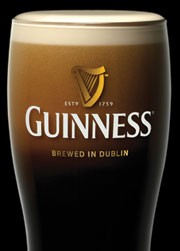Sinking bubbles in stout beers

Have you noticed that bubbles in conventional beers go up, but that they apparently go down in stout beers? This goes against conventional wisdom, but is quite simply explained in the end:
- there is a convection due to the shape of the glass. Larger at the top leads to an upward flow in the center of the glass and downwards at the edge, where the observer looks at.
- bubbles in stout beers are smaller, hence move upwards slower. In particular, in Guinness, the usage of nitrogen instead of pure dioxide leads to smaller bubbles.
- the combined effect of convection and smaller bubbles leads to bubbles going downwards at the edge.
I think it's a great happy hour anecdote!
There has been quite serious research done on the topic, by researcher William Lee and team: http://arxiv.org/abs/1205.5233
More details available at the following page:
Sinking Bubbles in Stout Beers

Video showing the falling bubbles:
Simulation of the downward flow at the edge:
See also:
How the widget in Guinness cans could be replaced with other materials while keeping the formation of the beer head once the can is opened. Contrary to dioxide bubbles, nitrogen bubbles do not form easily enough and need a little help.

Stout fizz-ics - Nature Physics
Nature Physics - Stout fizz-ics



